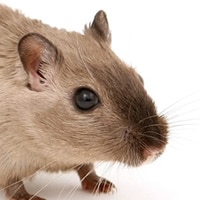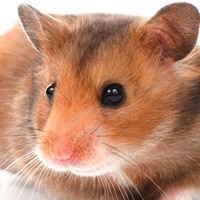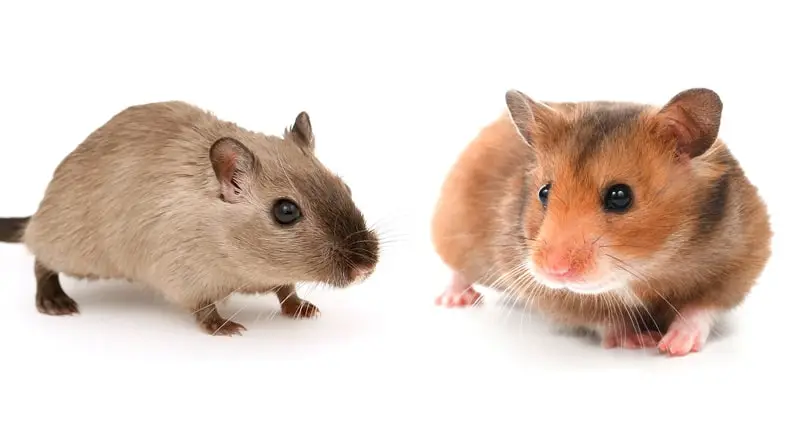If you’re looking for a new small critter companion, there’s a good chance that both gerbils and hamsters have crossed your mind. To most people, there isn’t much difference between these two creatures!
They’re both small, energetic, adorable, and so much fun to be around. But really, when looking at gerbils vs. hamsters, what sets these two apart from each other?
To sum it up briefly, gerbils are creatures that are very energetic and sociable, live very well in groups, and are always curious about what you’re doing. Hamsters are a bit more laid-back in nature, independent, and are very diverse in appearance and personality.
How Do Gerbils & Hamsters Compare?
So what exactly is the difference between gerbils and hamsters? It makes sense if you’re confused, as these creatures do have quite a few similarities! In fact, many people refer to gerbils as hamsters, not even knowing that the two are entirely different rodent species!
Lets take a look at some of the most prominent behavioral and physical similarities and differences between these two creatures.
Gerbil vs. Hamster Physical Appearances
At first glance, these two rodents look very similar. However, there’s actually quite a few differences between them in terms of size, color, and specific physical attributes.
All of these traits come together to create rodents that look quite different from each other. If a specific appearance is important to you, you should definitely be aware of these differences.

Gerbil Appearance
- Size – Gerbils tend to be smaller than hamsters, at least when comparing Mongolian gerbils to Syrian hamsters. Mongolian gerbils tend to grow to be between 5 and 6 inches long on average, not including their 3 to 4 inch-long tail. Mature gerbils grow to weigh just about 2 ounces. This smaller size can make gerbils a bit hard to handle, especially for children.
- Fur – Gerbils have a soft, dense coat that can come in a wide variety of different colors. In fact, some experts state that there’s between 40 and 50 different color combinations that gerbils can feature. The most common colors are gray, brown, tan, and a reddish-brown. Some gerbils have dark markings on their heads while others grow white patches behind their ears.
- Other traits – Gerbils have features that are more “long” than hamsters. They have longer, pointed noses like rats, long tails, and long hind legs that they frequently stand up on.

Hamster Appearance
- Size – Hamsters vary greatly in their size. While Syrian hamsters can grow to be between 5 and 7 inches long, dwarf hamsters only grow to be between 2 and 4 inches. Syrian hamsters weigh about 6 ounces on average, while dwarfs weigh only about 1.5 ounces. Since hamsters vary so much in size, it gives you more freedom in picking the size of your pet than gerbils do.
- Fur – Like their size, hamsters have a bit more variety in their fur. The fur can either be long or short, textured or smooth, and patterned or pattern-less. Possible hamster colors range from white to black to brown to gray. Male hamsters tend to have longer and fluffier hair than females. There’s even a hairless hamster if you’re interested in that appearance.
- Other traits – Hamsters are definitely more stubby in appearance. They have very short tails, a flatter face, and very short legs. Hamsters also have internal cheek pouches that they use to hold food, really emphasizing their round appearance.
Verdict
Gerbils and hamsters look similar at first glance, but they’re actually quite different! There are hamsters of all sizes, while the most common gerbils tend to be around the same length and weight. Hamsters also have quite a bit of variety in their fur in regards to length, style, and color, while gerbils primarily differ in color with 40-50 different color combos.
Gerbil vs. Hamster Behavioral Traits
While gerbils and hamsters look quite similar on the surface, underneath they’re entirely different animals!
It’s essential that you’re aware of the behavioral differences between gerbils and hamsters before making your choice, as behavior is a huge part of a pet. Fortunately, the differences are quite clear and easy to highlight.

Gerbil Behavior
- General behavior – Gerbils are commonly described as intelligent, curious, and very active creatures. They’re very interested in people and love to be kept around the action in your house. Since they aren’t nocturnal or diurnal, they get a really good feel for how the humans around them function. They’re also very active creatures. This means that they love to dig, jump, run, and be held.
- Aggressiveness – Gerbils are not very aggressive at all. They have a lot of energy, but that won’t be a problem if they’re given the means to get rid of any excess. You may get an occasional nibble from your gerbil, but anything more than that isn’t very common. If they do bite, it can usually be dealt with quickly.
- Independence – Being very social animals, gerbils need to be kept in groups of 2 or more. Solitary gerbils tend to get bored and sad, and this can lead to destructive behavior and poor health. On top of other gerbil friends, you should interact with your gerbil a good amount per day.

Hamster Behavior
- General behavior – Hamsters are mostly nocturnal, meaning that they spend most of the day sleeping. This makes early morning and evening the time to interact with your hamster — just don’t wake them up or startle them as they can be grumpy. During their active hours, hamsters construct burrows and make nests for storing food. Dwarf hamsters love environments that are full of stimuli, while Syrian hamsters actively seek out human interaction.
- Aggressiveness – Hamsters aren’t aggressive, but they aren’t as laid-back as gerbils are in this aspect. As stated, they can be a bit grumpy after waking up, so give them time to wake up before handling them. A hamster generally won’t bite you unless it feels threatened or scared, so move slowly and handle them with respect. They also sometimes bite hands if they smell a tasty scent on them.
- Independence – Most hamsters are very solitary and independent creatures. Hamsters should mostly be kept alone, with the exception of dwarf hamsters that were raised together since birth and have enough space.
Verdict
There are stark differences between gerbils and hamsters when it comes to personality. Gerbils are absolutely more sociable and energetic critters, thriving in groups and spending all day rearranging their tank. Hamsters are more laid-back and, while still entertaining and lively, definitely aren’t as energetic and sociable. So, if you want to be very involved with your pet and don’t mind having a few, gerbils are the way to go. However, if you want a pet that’s great on their own and a little more hands-off, it’s hamsters all the way.
Gerbil vs. Hamster Care & Health
As you’ve just learned, gerbils and hamsters have entirely different personalities. With this stark difference in personalities comes a big difference in how they need to be cared for.
Gerbils and hamsters each have specific environmental and health needs that need to be met in order to keep them happy and healthy.
Knowing what each of these rodents need as far as environment and care goes is extremely important if you’re thinking about owning one in the future.

Gerbil Care
- Cage – Gerbils are natural diggers and chewers, so they need an enclosure that can handle both of these traits. This makes a glass aquarium (with a mesh top) or a metal cage with a deep base pan the perfect gerbil enclosure. The deep basin-like design of an aquarium is perfect to fill with bedding and let gerbils burrow into it as they’re naturally inclined to do. Since they chew so much, no exposed plastic can be present within their habitat. The bigger the enclosure that you can get for your gerbils, the better. Note that it will need to be cleaned out about every two weeks.
- Diet – Gerbils are omnivores, but most of their foods are vegetarian. In the wild, they eat a mixture of grasses, fruits, roots, seeds, bulbs, nuts, and insects. You don’t have to exactly mimic this diet, but you should feed your gerbil a diet that’s similar in nature. Pet gerbils should have a diet consisting of a mixture of gerbil pellets, a high-quality seed mixture, and occasional fruits and vegetables. Nutritionally, they require 15-18% protein, 7-9% fat, and around 5% fiber, so their foods should meet those requirements.
- Health – Gerbils are quite resilient little creatures, living for a surprisingly long time for their small size. However, gerbils can suffer from dental disease, but this is largely avoided by providing them with enough safe objects to chew on. Some gerbils are also prone to several skin issues including mites and fur maters. A very common health issue with gerbils is epilepsy, with an estimated 40% of gerbils being affected by it. To avoid most of these problems, it helps to buy a gerbil from an experienced and trustworthy breeder.
- Lifespan – On average, gerbils tend to live for around 2 to 4 years. However, in some cases, there have been gerbils that live to be 8 to 10 years old! While most gerbils ultimately end up passing away at age 3, you have a very good chance of extending their lifespan by feeding them a good diet, providing them with a fun and safe environment, and purchasing a gerbil from a breeder that breeds healthy gerbils.

Hamster Care
- Cage – Hamsters are quite similar to gerbils in that they love to chew and dig. However, they thrive better in an environment that’s longer and wider than one that’s deep and filled with bedding. Since hamsters tend to make a single nest to sleep in and store their food, their messiness is more controlled than gerbils. So, their enclosure will only need to be cleaned out about once a month.
- Diet – A hamster diet is very similar to a gerbil diet. Wild hamsters are also omnivores, eating a mixture of grains, nuts, seeds, fruits, vegetables, frogs, lizards, and various insects. Similar to gerbils, hamsters also benefit from a mixture of specialized pelleted and mixed seed foods with fruit and veggie snacks thrown in. A hamster’s food should be at least 15% protein, 4-7% fat, and around 6-15% fiber.
- Health – Hamsters also suffer from dental disease, but it too can be avoided with the availability of a plethora of chew toys to keep tooth length down. Wet tail disease is a serious health condition that’s caused by bacteria and can turn fatal quickly. Hamsters are also prone to tumors, and these will require immediate veterinary care.
- Lifespan – Hamsters, on average, only live to be around 2 to 3 years old, with most hamsters only making it to age 2. Like with gerbils, there are outliers, but it is quite rare. Proper care and a genetically-healthy hamster will increase the chances of your hamster living past this age range, though.
Verdict
Gerbils and hamsters require different living spaces, but other than that they aren’t too different. Gerbils require a tank that’s entirely free of plastic and gives them massive amounts of space to dig and tunnel, while hamsters are similar but maybe not as extreme with their needs. Both creatures eat roughly the same food, are equally prone to health issues, and live just a couple of fun-filled years.
Should You Get A Gerbil Or A Hamster?
Ultimately, it comes down to you! Both of these fascinating creatures have traits that are unique to them and have caused them to become beloved by thousands, if not millions around the world.
Gerbils and hamsters do share some similarities, but they’re also quite different in their appearance, their temperament, and the care that they require. This is excellent, though, as that makes gerbils the perfect pet for some people while hamsters are perfect for others.
Whichever rodent you decide to go with, know that you’re going to have some very fun-filled years with them. Both gerbils and hamsters are capable of providing so much entertainment and affection towards you that’s so surprising coming out of their little bodies.

